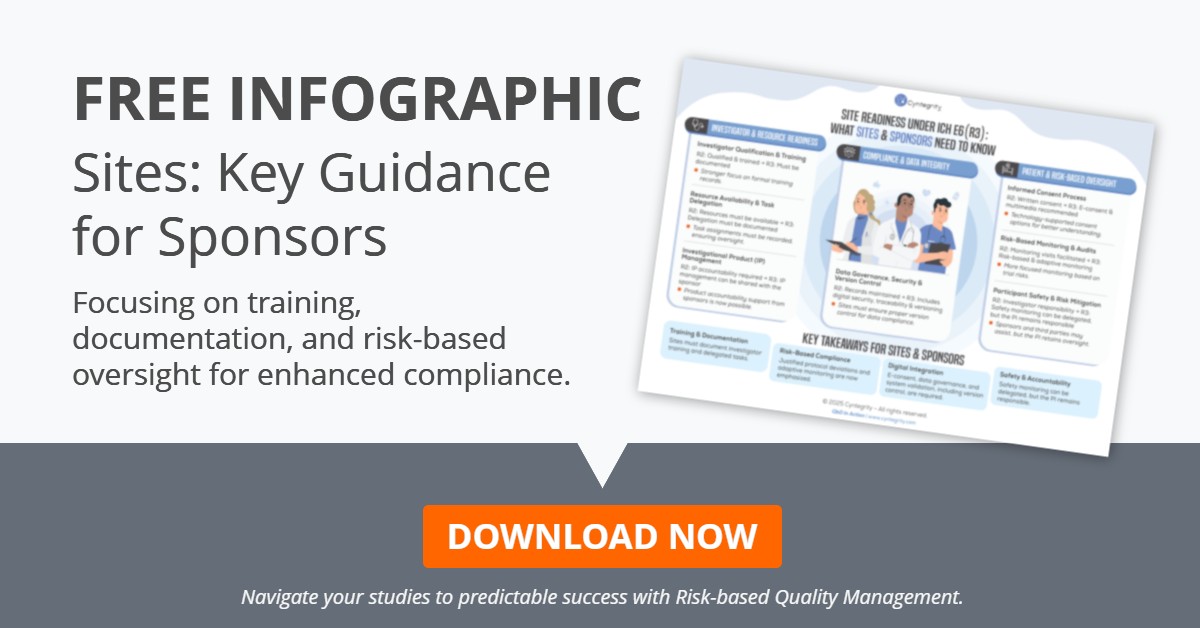How Quality by Design, Risk-Based Monitoring, and Risk-Based Quality Management Work Together in Clinical Trials
Clinical trials are essential to developing new drugs and therapies but can be complex and expensive. To improve the quality and efficiency of clinical trials, pharmaceutical companies and regulatory agencies have developed several approaches, including Quality by Design (QbD), Risk-Based Monitoring (RBM), and Risk-Based Quality Management (RBQM). In this article, we explore how QbD, RBM, and RBQM work together to improve the quality and efficiency of clinical trial conduct.
SECTION 1 – Quality by Design (QbD)
What is Quality by Design (QbD)?
Quality by Design (QbD) is a systematic approach to pharmaceutical development that aims to ensure quality is built into the clinical trial conduct from the beginning. QbD involves identifying and understanding the clinical trial’s critical to quality attributes or factors (CtQs) and then designing the trial process to produce results that meet these CtQs consistently.
QbD and ICH E8(R1)
The International Council for Harmonisation of Technical Requirements for Pharmaceuticals for Human Use (ICH) E8(R1) guideline on General Considerations for Clinical Trials defines QbD as the design of clinical trials that are planned and implemented in a way that focuses on good planning and implementation, including open dialogue and critical thinking, focusing on essential activities, and engaging stakeholders, including patient representatives. Section 3.1 of the ICH E8(R1) guideline emphasizes the importance of good planning and implementation in QbD of clinical studies.
How does QbD work in practice?
QbD involves a series of steps, including:
- Identifying the CtQs of the clinical trial
- Determining the trial process parameters that impact the CtQs
- Developing a design space that defines the acceptable range of process parameters
- Implementing a control strategy to ensure that the trial process stays within the design space
Good Planning and Implementation
By focusing on good planning and implementation, QbD can ensure the safety of participants and the validity of trial design. This can be achieved by designing trials with CtQs in mind and reducing the risks of adverse events.
Engaging Stakeholders, Including Patient Representatives
Engaging stakeholders, including patient representatives, is also an important aspect of QbD. This can ensure that the trial design meets the needs of patients and that patient safety is a top priority.
Ensuring Participant Safety and Validity of Trial Design
QbD can ensure the safety of participants and the validity of trial design by identifying and understanding the critical quality attributes or factors (CtQs) of the clinical trial and designing the trial process to consistently meet these CtQs.
Reducing Risks of Adverse Events
Designing trials with CtQs in mind can also reduce the risks of adverse events. By understanding the CtQs of the clinical trial, potential risks can be identified and minimized before the trial even begins.
Optimizing Trial Design and Treatment Protocols
QbD can optimize trial design and treatment protocols based on feedback from phase I and ensure reliable data collection that conforms to CtQs and optimizes resources based on the data. This can result in more efficient trial design and treatment protocols that better meet the needs of patients.
Ensuring Reliable Data Collection
Reliable data collection is another important aspect of QbD. By designing the trial process to consistently meet CtQs, data collection can be more reliable and consistent.
Collecting Data That Conforms to CtQs
Collecting data that conforms to CtQs is important for ensuring the reproducibility and consistency of results. By collecting data that conforms to CtQs, the data can be more easily analyzed and compared across trials.
Optimizing Resources Based on Data
By optimizing resources based on data, QbD can ensure that the trial is conducted in a way that is both efficient and effective. By focusing resources on the areas of highest risk, QbD can also reduce the overall monitoring burden.
Ensuring Reproducibility and Consistency of Results
QbD can ensure the reproducibility and consistency of results by designing the trial process to consistently meet CtQs. This can result in more reliable and consistent results that are easier to analyze and compare across trials.
Minimizing Risks of Product Failure and Regulatory Noncompliance
By collecting data that is reproducible and minimizing risks of errors or fraud, QbD can minimize risks of product failure and regulatory noncompliance. This can help to ensure that the trial is conducted in a way that meets regulatory requirements and produces reliable results.
Ensuring Compliance with Regulations
Ensuring compliance with regulations is another important aspect of QbD. By designing the trial process to consistently meet CtQs
QbD and Risk Management
QbD is closely related to RBQM because both approaches focus on risk management and quality improvement. By identifying the CtQs of the clinical trial and designing the trial process to meet these CtQs consistently, QbD helps to reduce the risk of trial failure and noncompliance with regulatory requirements.
SECTION 2 – Risk-Based Monitoring (RBM) and Risk-Based Quality Management (RBQM)
What are RBM and RBQM?
Risk-Based Monitoring (RBM) is an approach to monitoring clinical trials that involves focusing resources on the areas of highest risk. RBM is a subset of RBQM, which is a broader approach to managing clinical trial quality. RBQM involves a continuous cycle of planning, implementation, evaluation, and improvement to ensure that the trial is conducted in a way that meets regulatory requirements and produces reliable results.
How do RBM and RBQM work in practice?
RBM is typically implemented as part of a larger RBQM plan. The RBQM plan will identify the risks to trial quality, including risks related to patient safety, data integrity, and trial conduct. The plan will also identify the monitoring activities that are necessary to manage those risks, including the frequency and scope of monitoring activities.
RBM as a subset of RBQM
RBM is a critical component of RBQM because it allows sponsors to focus their monitoring resources on the areas of highest risk. By using RBM, sponsors can reduce the overall burden of monitoring activities while ensuring that the trial is conducted in a safe and effective manner.
| Principle | Definition | Phase 1 Benefits | Phase 2 Benefits | Phase 3 Benefits |
|---|---|---|---|---|
| Quality by Design (QbD) | A systematic approach to ensuring quality is built into the clinical trial process from the beginning by identifying and understanding the critical to quality attributes (CtQs) of the clinical trial and designing the trial process to consistently meet these CtQs. | Ensure the safety of participants and the validity of trial design. Design trials with CtQs in mind and reduce risks of adverse events. | Optimize trial design and treatment protocols based on feedback from phase I and ensure reliable data collection. Collect reliable data that conforms to CtQs and optimize resources based on the data. | Ensure the reproducibility and consistency of results, minimize risks of product failure and regulatory noncompliance. Collect data that is reproducible, minimize risks of errors or fraud, and ensure compliance with regulations. |
| Risk-based Monitoring (RBM) | An approach to monitoring clinical trials that involves focusing resources on the areas of highest risk. | Reduce risks to participant safety and ensure the validity of trial design. Monitor high-risk areas and collect data to ensure the safety of participants. | Minimize risks of data errors or fraud, optimize data collection, and reduce resource allocation to low-risk areas. Optimize data collection and reduce the overall monitoring burden by focusing on high-risk areas. | Ensure data quality, optimize resource allocation, and detect issues early to reduce risks of product failure and regulatory noncompliance. Monitor data quality and ensure that resources are allocated effectively to detect issues early. |
| Risk-based Quality Management (RBQM) | A broader approach to managing clinical trial quality that involves a continuous cycle of planning, implementation, evaluation, and improvement to ensure that the trial is conducted in a way that meets regulatory requirements and produces reliable results. | Ensure the safety of participants and the validity of trial design, optimize resource allocation, and reduce risks of data errors or fraud. Develop a plan for risk management and quality improvement that is tailored to the specific trial. | Optimize trial design and treatment protocols based on feedback from phase 1, ensure data quality, and reduce risks of product failure and regulatory noncompliance. Continuously evaluate trial performance and optimize resource allocation. | Ensure the reproducibility and consistency of results, optimize resource allocation, detect issues early, and reduce risks of product failure and regulatory noncompliance. Continuously monitor trial performance, analyze data, and make adjustments to ensure that the trial is conducted in a safe and effective manner. |
Overall, QbD, RBM, and RBQM provide a comprehensive approach to managing clinical trial quality and efficiency. By incorporating these principles into their trial management processes, pharmaceutical companies can reduce the risk of trial failure and regulatory noncompliance, while also improving patient safety and producing reliable results.
ICH and FDA Guidelines for RBM and RBQM
The International Council for Harmonisation (ICH) has published guidelines related to RBM/RBQM, including the ICH E6(R2) guideline on Good Clinical Practice. This guideline emphasizes the importance of a risk-based approach to clinical trial monitoring and quality management and provides recommendations for implementing RBM/RBQM in clinical trials. The US Food and Drug Administration (FDA) has also published guidance related to RBM/RBQM, including recommendations for implementing a risk-based approach to clinical trial monitoring and emphasizing the importance of focusing monitoring activities on the areas of highest risk to patient safety, data integrity, and trial conduct.
Conclusion: In conclusion, Quality by Design, Risk-Based Monitoring, and Risk-Based Quality Management are all fundamental approaches to improving the quality and efficiency of clinical trial conduct. QbD focuses on ensuring that quality is built into the clinical trial process from the beginning, while RBM and RBQM focus on risk management and quality improvement throughout the clinical trial process.
By incorporating QbD principles into the clinical trial design process and implementing RBM/RBQM in clinical trials, pharmaceutical companies can reduce the risk of trial failure and regulatory noncompliance, while also reducing the time and cost required to bring new drugs and therapies to market.
The ICH and FDA guidelines provide helpful guidance for implementing these approaches in practice. Pharmaceutical companies should consider incorporating these principles into their trial management processes to improve their clinical trials’ overall quality and efficiency. By doing so, they can ensure that their trials are conducted safely and effectively, producing reliable results and ultimately bringing safe and effective treatments to patients who need them.
NEW | The Clinical Researcher’s Guide to RBQM
Discover the future of clinical research with “The Clinical Researcher’s Guide to RBQM” by Artem Andrianov, PhD, and Johann Proeve, PhD.
This comprehensive guide (160+ pages Kindle edition) explores the principles of risk-based quality management, offering invaluable insights for optimizing clinical trials. Don’t miss your chance to be at the forefront of innovation in biopharmaceutical product development.







